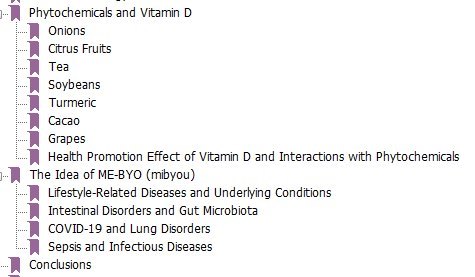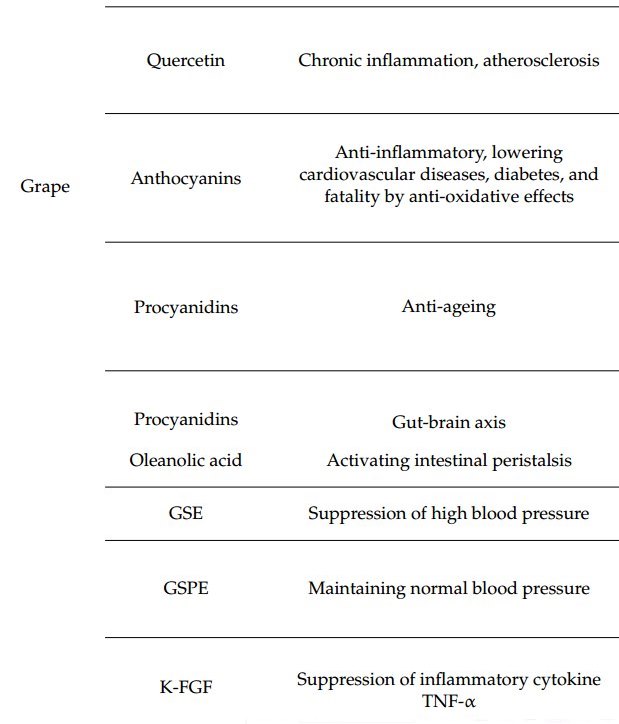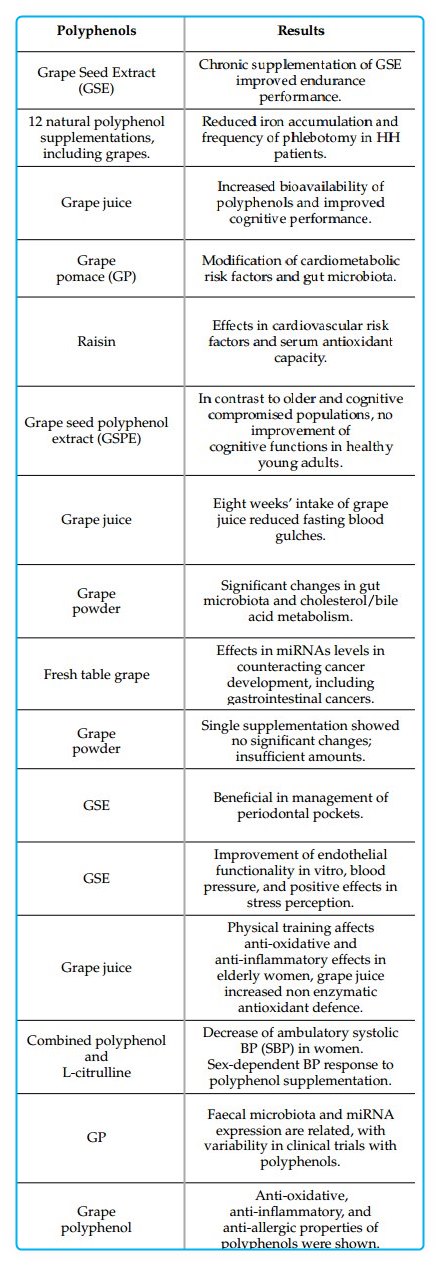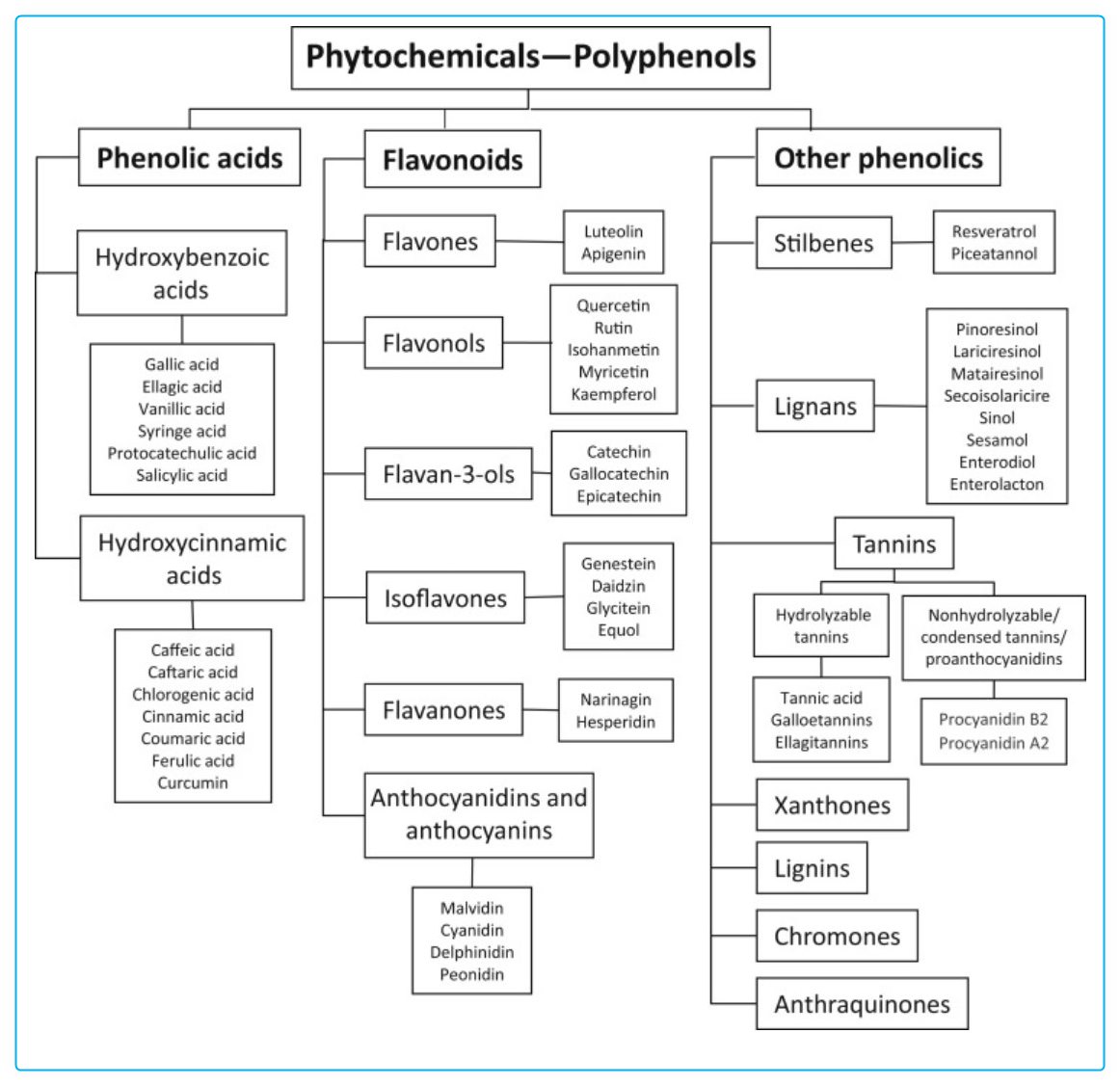Phytochemicals (Quercetin, Resveratrol, Tumeric, etc.) plus Vitamin D
Phytonutrients, also called phytochemicals or antioxidants,
are compounds produced by plants that provide health benefits to the body
Phytochemicals and Vitamin D for a Healthy Life and Prevention of Diseases - July 2023
Int J Mol Sci . 2023 Jul 29;24(15):12167. doi: 10.3390/ijms241512167.
Kazuki Santa 1, Kenji Watanabe 2 3, Yoshio Kumazawa 4 5, Isao Nagaoka 5 6
Table of Contents



Grape Randomized Controlled Trials

A variety of phytocompounds contained in medical plants have been used as medication, including Kampo (traditional Japanese) medicine. Phytochemicals are one category of the chemical compounds mainly known as antioxidants, and recently, their anti-inflammatory effects in preventing chronic inflammation have received much attention. Here, we present a narrative review of the health-promotion and disease-prevention effects of phytochemicals,
including polyphenols , the latter of which are abundant in
onions,
oranges,
tea,
soybeans,
turmeric,
cacao, and
grapes,
- along with the synergetic effects of vitamin D .
A phenomenon currently gaining popularity in Japan is finding non-disease conditions, so-called ME-BYO (mibyou) and treating them before they develop into illnesses . In addition to lifestyle-related diseases such as metabolic syndrome and obesity, dementia and frailty, commonly found in the elderly, are included as underlying conditions. These conditions are typically induced by chronic inflammation and might result in multiple organ failure or cancer if left untreated. Maintaining gut microbiota is important for suppressing (recently increasing) intestinal disorders and for upregulating immunity. During the COVID-19 pandemic, the interest in phytochemicals and vitamin D for disease prevention increased, as viral and bacterial infection to the lung causes fatal inflammation, and chronic inflammation induces pulmonary fibrosis. Furthermore, sepsis is a disorder inducing severe organ failure by the infection of microbes, with a high mortality ratio in non-coronary ICUs. However, antimicrobial peptides (AMPs) working using natural immunity suppress sepsis at the early stage. The intake of phytochemicals and vitamin D enhances anti-inflammatory effects, upregulates immunity, and reduces the risk of chronic disorders by means of keeping healthy gut microbiota. Evidence acquired during the COVID-19 pandemic revealed that daily improvement and prevention of underlying conditions, in terms of lifestyle-related diseases, is very important because they increase the risk of infectious diseases. This narrative review discusses the importance of the intake of phytochemicals and vitamin D for a healthy lifestyle and the prevention of ME-BYO, non-disease conditions.
📄 Download the PDF from VitaminDWiki
Phytochemicals are produced by plants to fight off fungi, bacteria, virus and consumption by animals.
https://en.wikipedia.org/wiki/Phytochemical
50,000 phytochemicals are in many categories:
carotenoids and polyphenols
polyphenols: phenolic acids, flavonoids, stilbenes or lignans.
Flavonoids: anthocyanins, flavones, flavanones, isoflavones, and flavonols.
Flavanols: catechins, epicatechins, and proanthocyanidins.
Chart of Phytochemicals

5 recent publications on Phytochemicals and Vitamin D
Editorial: Rising stars in nutrition and inflammation - April 2023 10.3389/fnut.2023.1197351 FREE PDF
Prevention of Metabolic Syndrome by Phytochemicals and Vitamin D - July 2023 doi: 10.3390/ijms241512167 FREE PDF
Healthy Diet, Grape Phytochemicals, and Vitamin D: Preventing Chronic Inflammation and Keeping Good Microbiota - 2023 : https://doi.org/10.2174/1871530323666221017151705
Potential tactics with vitamin D and certain phytochemicals for enhancing the effectiveness of immune-checkpoint blockade therapies - June 2023 doi: 10.37349/etat.2023.00145 FREE PDF
VitaminDWiki - Vitamin D Receptor activation can be increased in 14 ways
Omega-3, Magnesium, Zinc, Quercetin, non-daily Vit D, Curcumin, intense exercise, Butyrate Ginger, Essential oils, etc Note: The founder of VitaminDWiki uses 10 of the 14 known VDR activators
11+ VitaminDWiki pages with QUERCETIN in the title
This list is automatically updated
{LIST()}
Quercetin for 12 weeks reduced fatty liver disease and reduced weight by 3.3 lbs - RCT July 2024
Quercetin intervention reduced hepatic fat deposition in patients with nonalcoholic fatty liver disease: a randomized, double-blind, placebo-controlled crossover clinical trial
Am J Clin Nutr 2024 Jul 18:S0002-9165(24)00610-5. doi: 10.1016/j.ajcnut.2024.07.013
Full PDF is behind paywall, but portions are available on the website for free
Background
Non-alcoholic fatty liver disease (NAFLD) has become a growing public health problem worldwide. However, there is still lack of effective treatment strategies except lifestyle intervention.
Objective
To evaluate whether quercetin improves intrahepatic lipid content in patients with NAFLD.
Methods
In this randomized, double-blind, placebo-controlled crossover trial, 41 patients with NAFLD were randomly assigned to receive the quercetin (500 mg) or placebo capsules for 12 weeks, then switched interventions for another 12 weeks after a 4-week washout period. The primary outcome was intrahepatic lipid content evaluated by magnetic resonance imaging estimated proton density fat fraction. The secondary outcomes were liver function measurements, etc. Safety outcomes included blood routine.
Results
36 patients completed the trial. In ITT analyses, the quercetin intervention moderately decreased the intrahepatic lipid contents from 11.5±6.4% to 9.6±5.8%, compared with the placebo intervention (decreased by 0.1±2.6%, P=0.013 and adjusted P value is 0.028).
Body weight and body mass index were mildly reduced by 1.5±2.6 kg and 0.5±0.9 kg/m2 after the quercetin intervention (P<0.05 and both adjusted P values are 0.038), while the reductions were only 0.2±1.8 kg and 0.1±0.7 kg/m2 after the placebo intervention.
The intrahepatic lipid contents reductions were noticeably positively associated with the body weight losses after the quercetin and placebo interventions (r=0.557 and 0.412, P<0.001 and =0.007, respectively). Subgroup analyses found that the reduction of intrahepatic lipid contents in females (3.0±3.7%) was about twice as large as in males (1.4±2.5%) with a trend of statistically significance (P=0.113 and adjusted P value is 0.061). There were no significant differences in other secondary and safety outcomes. No adverse events associated with study intervention were found.
Conclusions
Twelve weeks treatment of quercetin could reduce intrahepatic lipid contents in patients with NAFLD, possibly explained by a slightly larger body weight loss in the quercetin group. The trial is registered at www.chictr.org.cn as ChiCTR2100047904.
18+ VitaminDWiki pages with CURCUMIN in the title
This list is automatically updated
{LIST()}
Turmeric for Chronic Pain - Green Med Info 2022
VitaminDWiki – Resveratrol improves health (Vitamin D receptor, etc.) - many studies contains
{include}
VitaminDWiki – Vitamin D Receptor category contains
{include}
Diseases associated with a poor Vitamin D Receptor
{include}
Is BHT a phytochemical? It fights many enveloped viruses
A Quick Look at BHT - Aug 2023 substack
- "(A seemingly magic bullet for lipid-coated viruses with anti-aging properties)"
